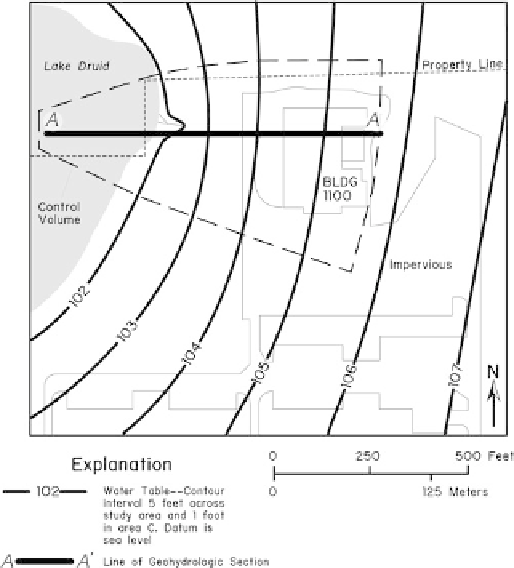Environmental Engineering Reference
In-Depth Information
literature (Chapelle et al. 1996; Wiedemeier et al. 1996;
Landmeyer et al. 2009). Essentially, the difference in con-
taminant concentration between two wells can be used to
determine loss rates assumed to be due to biodegradation. A
third approach to determine biodegradation rates from field
data is to use a method based on flux. This method overcomes
some of the limiting assumptions of the flowpath method. It
was used at a landfill site (Dinicola et al. 2002) and at sites of
MTBE-contaminated groundwater discharge (Landmeyer
et al. 2001) and MTBE-, TAME-, and TBA-contaminated
groundwater discharge (Landmeyer et al. 2010).
represent dissolved substances will be captured by areas
proposed to be or have been planted.
14.5.2 Case Study in Florida
The MODFLOW model was used to determine if existing
vegetation could be used to capture contaminated groundwa-
ter before it discharged contaminants to a surface-water body
(Halford 1998). At the site in Orlando, Florida, groundwater
contaminated by chlorinated solvents from a dry-cleaning
facility was discharging to Lake Druid about 500 ft (152 m)
downgradient from the source area (Fig.
14.1
). The shallow
water-table aquifer consisted of fine-grained sand, which
would increase the potential for any interaction between
groundwater and trees if phytoremediation were used as a
remedial strategy. The hydraulic conductivity of these sands
was between 10 and 40 ft/day (3-12 m/day).
The conceptual model of the site depicts that water
input (precipitation and irrigation) is about 57 in./year
(144 cm) and that
ET
removes about 34 in./year (86 cm/
year) (Fig.
14.2
). The study area was developed in both the
horizontal and vertical dimensions. Horizontally, it was
discretized into a grid composed of cells where finite-difference
approximations to the groundwater-flow equation could be
solved. In order to reduce the potential for complications in
the computed groundwater elevations that arise near model
14.5 Use of Existing Groundwater Flow and
Solute-Transport Models That
Incorporate Plant-Related Processes
The concept of a water budget was introduced in Chap. 2.
Although deceptively simple, it provides a useful conceptual
framework to assess the effect of different components of the
water budget on a particular site's hydrology. Under simple
site conditions or restrictive assumptions, it may be possible
to answer some qualitative questions regarding the compart-
mentalization of water within a basin (see Lindgren 1903).
Under most site conditions, however, contaminants are pres-
ent and hydrogeologic conditions are more complex.
Numerical models that represent solutions to calculus-
based formulas that describe groundwater flow and solute
transport are often the best tools to use.
Groundwater-flow models can be used to simulate the
various processes that affect the movement of groundwater
in aquifer media. Although such models do not account
directly for the movement of solutes being carried in the
water phase, groundwater-flow models can be used to deter-
mine the effect of one component of the proposed solute-
transport equation, and that is the uptake of groundwater by
plants. Because this uptake involves at least some water
from the unsaturated zone, a model should be able to simu-
late flow in the unsaturated zone. The movement of water in
the vadose zone often is simulated by the Richards equation.
14.5.1 Groundwater-Flow Models
The groundwater flow model MODFLOW (McDonald and
Harbaugh 1988) is a widely used model to address ground-
water flow issues. The most recent version is MODFLOW-
2005 (Harbaugh 2005). It has a subroutine, or module, that
describes the impact of
ET
on groundwater levels, and the
reverse. If coupled with the model's particle tracking mod-
ule called MODPATH, then it can be used to determine not
only if plants are going to affect the direction of groundwater
flow and the volume removed, but also if particles that
Fig. 14.1
Diagram representing Florida case study of effect of a
potential phytoremediation planting on groundwater flow (Modified
from Halford 1998). One foot is equivalent to 0.305 m.



Search WWH ::

Custom Search